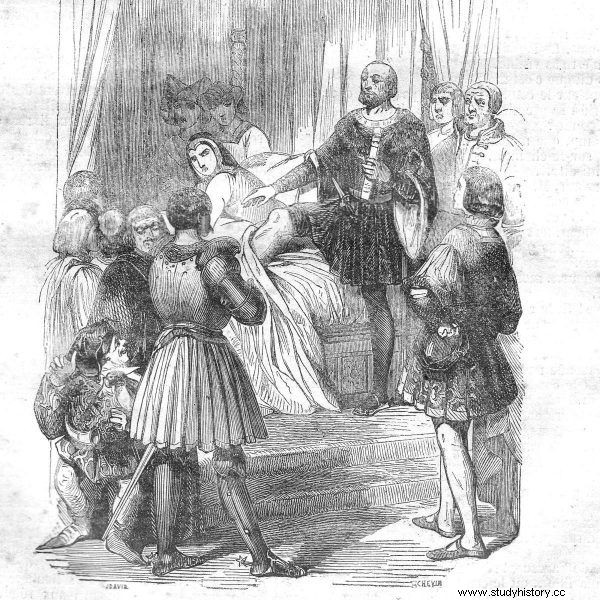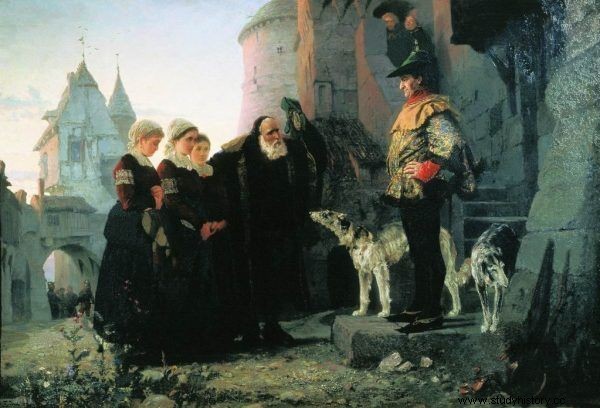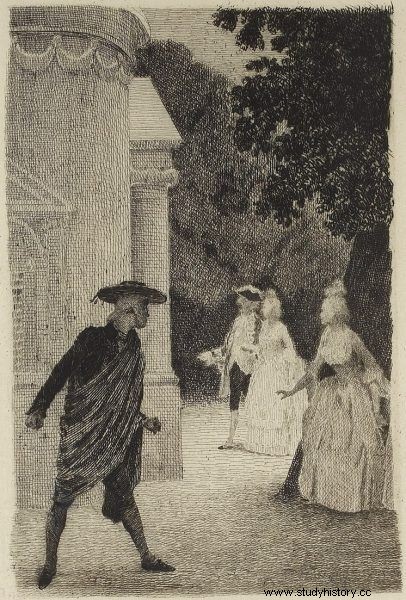There is probably no other medieval custom that would become so infamous. About almost the first night, ius primae noctis, everyone heard. But was this barbaric recipe really in place?
18th-century Europe was truly obsessed with the Middle Ages. In the period of enlightenment, rush for knowledge and criticism of all superstitions made of the dark ages a whipping boy. In fact, it was then that the very term "dark ages" became popular, depreciating the true achievements of the Middle Ages and, in fact, deleting a thousand years of history as a shameful, primitivist-filled stain.

Le Droit du Seigneur. A painting by Jules Garnir from the second half of the 19th century.
To prove that the dark ages were indeed plunged into complete moral darkness, the authorities of the eighteenth century cited, for example, the "law of the first night." It was argued that in this brutal and disgusting era, the rule was that feudal lords had the privilege of having their first sexual intercourse with each of their subjects when they were married. It was supposed to come down to the rape of a woman, which she could only avoid if her family paid you the appropriate ransom.
Fantasy or reality?
About almost the first night, also referred to in French as droit du seigneur , wrote the influential philosopher and humanist Voltaire. Playwright Pierre Beaumarchais even composed a five-act comedy Crazy Day, or Figaro's Wedding , about how the slimy count tries to force a beautiful subject to devote herself to him according to the eternal law.

The law of the first night on a French illustration from the mid-19th century
The piece not only gained enormous popularity, but also became an inspiration for Wolfgang Mozart and his own opera The Marriage of Figaro. No wonder then that the law of the first night has become a widely recognized theme. And at the same time:the subject of a huge and extremely heated discussion among scientists. Everyone wanted to know where the legend ends and reality begins.
At the turn of the 19th and 20th centuries, a consensus was established after dozens, if not hundreds, of hermetic desiderata. As reported by Encyclopedia Britannica in the 1911 edition:“There is no credible evidence that the custom existed in a codified form. It seems to be a myth created not earlier than in the 16th or 17th century. " This sentence actually holds up to this day.
According to the Encyclopedia of Rape , The Rape Encyclopedia published in 2004:"historians generally agree that law it was merely a legend and probably never existed in practice. The term was by no means born in the Middle Ages, but in debates in the 16th century.

The law of the first night in the painting by Vasily Polenov.
Contrary to these claims, the scientific debate has not died down at all. And the search for the true roots of the law on the first night had not stopped. The research results from the last decades are surprising. It turns out that the custom was not only real, but also much older than it might seem.
An age-old tradition
First, the droit du seigneur tradition it was already known to people of deep antiquity. The epic of Gilgamesh, a work written thousands of years before our era, stated that the main character “had intercourse with married women; he first, and the husband after him. " Later, the Greek writer Herodotus also told about a similar privilege, reportedly effective in Libya, followed by Heraklides Ponticos (around 400 BC) and Valerius Maximus (AD 20).
The Law of the First Night has become an attractive literary theme. They were quoted on the occasion of stories either about foreign, wild countries, or - about tyrants and invaders who were wanted to disgust the reader. Also in this form ius primae noctis was adapted by medieval chroniclers. For example, as early as the 8th century, the year-olds of the Conmacnosie abbey in Ireland scared the Vikings, whose chief demanded "a first marriage night with every woman, so that he could experience her body before her husband did it and satisfy his lust".
Later, the stories of custom also penetrated into literature - into the medieval counterparts of today's novels. For example, the famous French epic from the 14th century, Baudouin de Sebourc he was telling about nothing else, but about a despot who gives his subjects only two options:he will either deflower the virgin or seize her dowry.
There can be no doubt that the people of the Middle Ages knew the customs under analysis well. Other sources also indicate that it was not considered a legend at all, but rather - a real recipe taken from common law. Jörg Wettlaufer, author of the research work The jus primae noctis as a male power display cites, for example, monastic records from 13th-century Normandy, also linking the law of the first night with a dowry.

Illustration from the 19th-century edition of The Marriage of Figaro.
"We have strong premises to assume that the link between wedding fees and the tradition of jus primae noctis dates back to the early Middle Ages and has its roots in Germanic wedding customs, "emphasizes Wettlaufer.
However, this is not the end of the "premises". It was also possible to track down hard documents, leaving no doubts as to the true picture of the case.
Hard evidence
In the Swiss archives, a collection of regulations in force in the village of Maur, located just outside Zurich, dating back to about 1400 has been preserved. One of the rules issued by the local lord's representative was:
Those wishing to enter into holy marriage should hand over the woman to us for the first night or he may redeem her according to custom and tradition and in ancient scriptures. If it fails to do so, it will be fined.

Wedding night on a 15th-century engraving
In Catalonia, in turn, the custom of the first night became one of the premises leading to a great peasant rebellion at the end of the fifteenth century. The preserved documents indicate that the peasants complained that the feudal lords entered the beds of brides, harassed and humiliated them. Other, more enigmatic sources also come from France or Italy.
So it seems that in almost all of Western Europe the custom of the first night was known, and in many places also enforced. It should be emphasized, however, that, according to all sources, it was treated as an old tradition, not an excuse to rape women with impunity. The gentlemen humiliated their subjects, but they were always content with a fine. And so far not a single written testimony has been found to prove that any lord actually replaced the groom in the bed.
Middle Ages and the law of the first night. True
Bibliography:
- Corley Christopher, Droit du seigneur [in:] Encyclopedia of Rape , Eds. Merril D. Smith, Greenwood Press, Westport-London 2004.
- Howarth W.D., “Droit du Seingeur” . Fact or Fantasy , Journal of European Studies, vol. 1 (1971).
- Jus Primae Noctis [in:] 1911 Encyclopaedia Britannica , vol. 15 (accessed September 9, 2018).
- Wettlaufer Jörg, Das Herrenrecht der ersten Nacht. Hochzeit, Herrschaft und Heiratszins im Mittelalter und in der frühen Neuzeit , "Historische Forschungen", vol. 27 (1999).
- Wettlaufer Jörg, The jus primae noctis as a male power display. A review of historic sources with evolutionary interpretation , "Evolution and Human Behavior," vol. 21 (2000).
